JEEP WRANGLER UNLIMITED 2020 Owner handbook (in English)
Manufacturer: JEEP, Model Year: 2020, Model line: WRANGLER UNLIMITED, Model: JEEP WRANGLER UNLIMITED 2020Pages: 330, PDF Size: 9.16 MB
Page 201 of 330
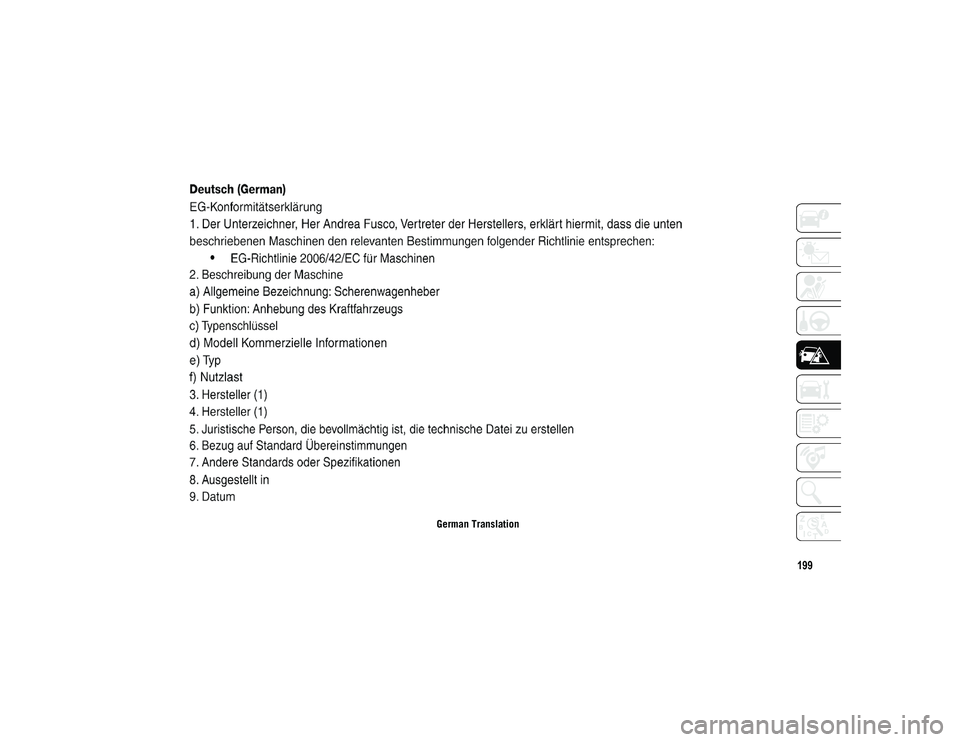
199
German Translation
2020_JEEP_JL_WRANGLER_UG_RHD_UK.book Page 199
Page 202 of 330
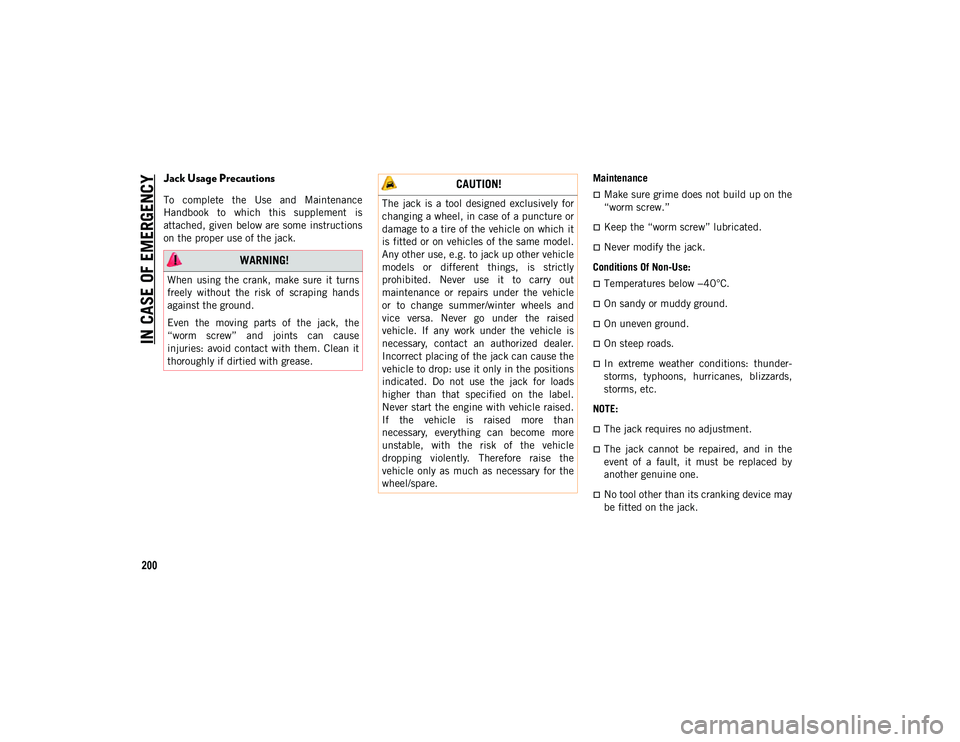
IN CASE OF EMERGENCY
200
Jack Usage Precautions
To complete the Use and Maintenance
Handbook to which this supplement is
attached, given below are some instructions
on the proper use of the jack.MaintenanceMake sure grime does not build up on the
“worm screw.”
Keep the “worm screw” lubricated.
Never modify the jack.
Conditions Of Non-Use:
Temperatures below −40°C.
On sandy or muddy ground.
On uneven ground.
On steep roads.
In extreme weather conditions: thunder -
storms, typhoons, hurricanes, blizzards,
storms, etc.
NOTE:
The jack requires no adjustment.
The jack cannot be repaired, and in the
event of a fault, it must be replaced by
another genuine one.
No tool other than its cranking device may
be fitted on the jack.
WARNING!
When using the crank, make sure it turns
freely without the risk of scraping hands
against the ground.
Even the moving parts of the jack, the
“worm screw” and joints can cause
injuries: avoid contact with them. Clean it
thoroughly if dirtied with grease.
CAUTION!
The jack is a tool designed exclusively for
changing a wheel, in case of a puncture or
damage to a tire of the vehicle on which it
is fitted or on vehicles of the same model.
Any other use, e.g. to jack up other vehicle
models or different things, is strictly
prohibited. Never use it to carry out
maintenance or repairs under the vehicle
or to change summer/winter wheels and
vice versa. Never go under the raised
vehicle. If any work under the vehicle is
necessary, contact an authorized dealer.
Incorrect placing of the jack can cause the
vehicle to drop: use it only in the positions
indicated. Do not use the jack for loads
higher than that specified on the label.
Never start the engine with vehicle raised.
If the vehicle is raised more than
necessary, everything can become more
unstable, with the risk of the vehicle
dropping violently. Therefore raise the
vehicle only as much as necessary for the
wheel/spare.
2020_JEEP_JL_WRANGLER_UG_RHD_UK.book Page 200
Page 203 of 330

201
JUMP STARTING
If your vehicle has a discharged battery, it
can be jump started using a set of jumper
cables and a battery in another vehicle, or by
using a portable battery booster pack. Jump
starting can be dangerous if done improp-
erly, so please follow the procedures in this
section carefully.
NOTE:
When using a portable battery booster pack,
follow the manufacturer's operating instruc -
tions and precautions.
Preparations For Jump Start
The battery in your vehicle is located in the
left rear of the engine compartment.
Positive Battery Post
Positive Battery Post NOTE:
The positive battery post is covered with a
protective cap. Lift up on the cap to gain
access to the post.
WARNING!
Do not attempt jump starting if the battery
is frozen. It could rupture or explode and
cause personal injury.
CAUTION!
Do not use a portable battery booster pack
or any other booster source with a system
voltage greater than 12 Volts or damage to
the battery, starter motor, alternator or
electrical system may occur.
WARNING!
Take care to avoid the radiator cooling
fan whenever the hood is raised. It can
start anytime the ignition switch is ON.
You can be injured by moving fan blades.
Remove any metal jewelry such as rings,
watch bands and bracelets that could
make an inadvertent electrical contact.
You could be seriously injured.
Batteries contain sulfuric acid that can
burn your skin or eyes and generate
hydrogen gas which is flammable and
explosive. Keep open flames or sparks
away from the battery.
2020_JEEP_JL_WRANGLER_UG_RHD_UK.book Page 201
Page 204 of 330
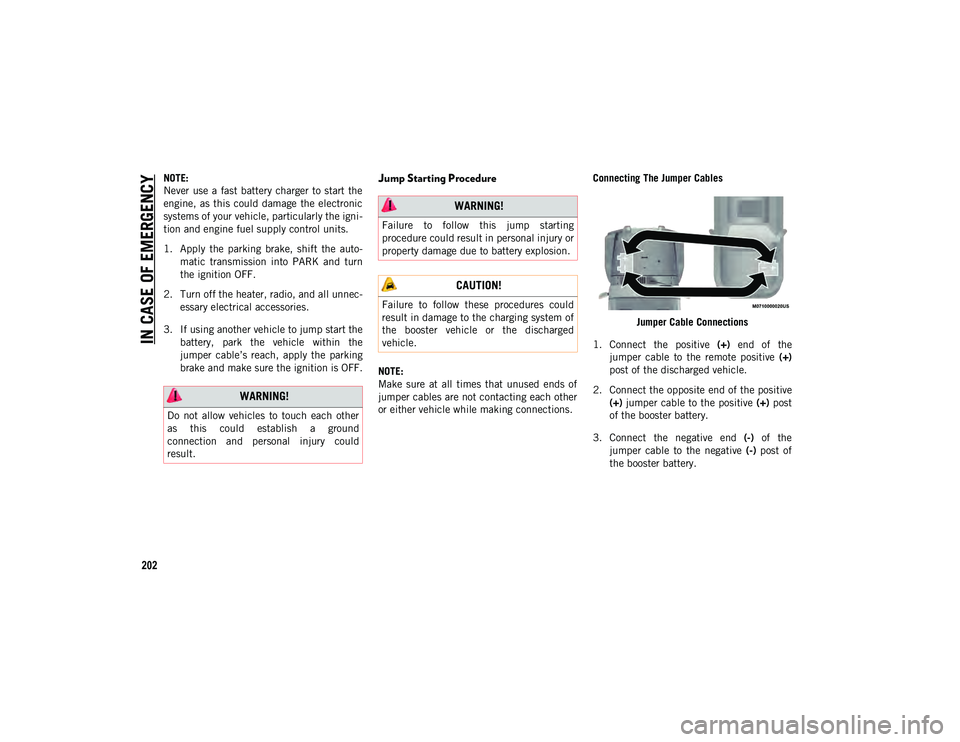
IN CASE OF EMERGENCY
202
NOTE:
Never use a fast battery charger to start the
engine, as this could damage the electronic
systems of your vehicle, particularly the igni-
tion and engine fuel supply control units.
1. Apply the parking brake, shift the auto -
matic transmission into PARK and turn
the ignition OFF.
2. Turn off the heater, radio, and all unnec -
essary electrical accessories.
3. If using another vehicle to jump start the battery, park the vehicle within the
jumper cable’s reach, apply the parking
brake and make sure the ignition is OFF.Jump Starting Procedure
NOTE:
Make sure at all times that unused ends of
jumper cables are not contacting each other
or either vehicle while making connections. Connecting The Jumper Cables
Jumper Cable Connections
1. Connect the positive (+) end of the
jumper cable to the remote positive (+)
post of the discharged vehicle.
2. Connect the opposite end of the positive (+) jumper cable to the positive (+) post
of the booster battery.
3. Connect the negative end (-) of the
jumper cable to the negative (-) post of
the booster battery.
WARNING!
Do not allow vehicles to touch each other
as this could establish a ground
connection and personal injury could
result.
WARNING!
Failure to follow this jump starting
procedure could result in personal injury or
property damage due to battery explosion.
CAUTION!
Failure to follow these procedures could
result in damage to the charging system of
the booster vehicle or the discharged
vehicle.
2020_JEEP_JL_WRANGLER_UG_RHD_UK.book Page 202
Page 205 of 330
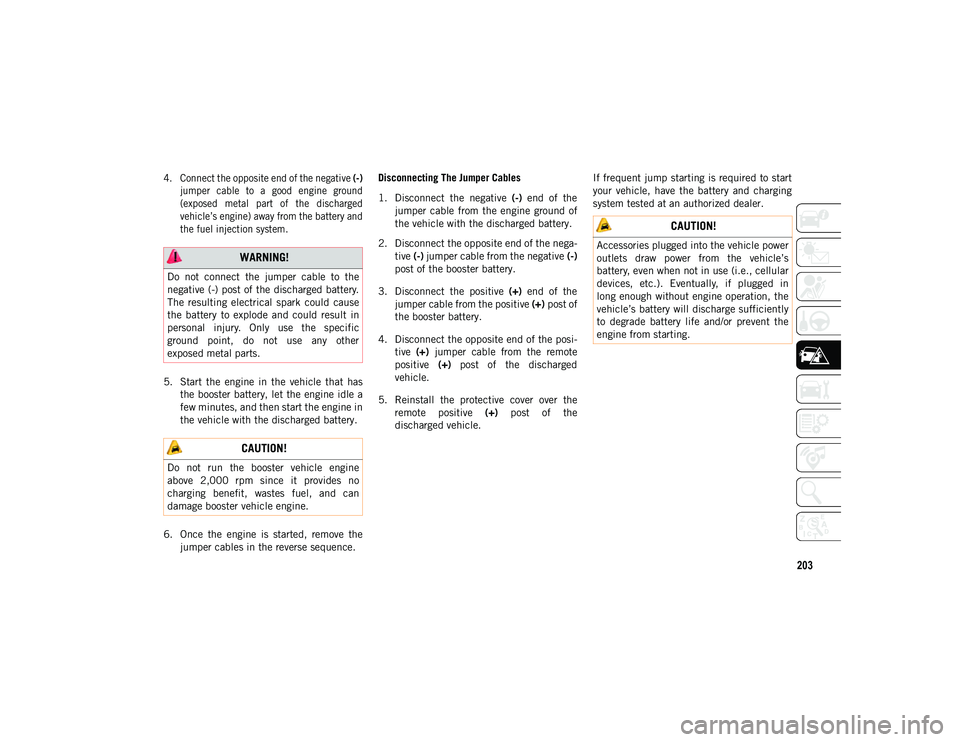
203
4. Connect the opposite end of the negative (-)
jumper cable to a good engine ground
(exposed metal part of the discharged
vehicle’s engine) away from the battery and
the fuel injection system.
5. Start the engine in the vehicle that has the booster battery, let the engine idle a
few minutes, and then start the engine in
the vehicle with the discharged battery.
6. Once the engine is started, remove the jumper cables in the reverse sequence. Disconnecting The Jumper Cables
1. Disconnect the negative
(-) end of the
jumper cable from the engine ground of
the vehicle with the discharged battery.
2. Disconnect the opposite end of the nega -
tive (-) jumper cable from the negative (-)
post of the booster battery.
3. Disconnect the positive (+) end of the
jumper cable from the positive (+) post of
the booster battery.
4. Disconnect the opposite end of the posi -
tive (+) jumper cable from the remote
positive (+) post of the discharged
vehicle.
5. Reinstall the protective cover over the remote positive (+) post of the
discharged vehicle. If frequent jump starting is required to start
your vehicle, have the battery and charging
system tested at an authorized dealer.
WARNING!
Do not connect the jumper cable to the
negative (-) post of the discharged battery.
The resulting electrical spark could cause
the battery to explode and could result in
personal injury. Only use the specific
ground point, do not use any other
exposed metal parts.
CAUTION!
Do not run the booster vehicle engine
above 2,000 rpm since it provides no
charging benefit, wastes fuel, and can
damage booster vehicle engine.
CAUTION!
Accessories plugged into the vehicle power
outlets draw power from the vehicle’s
battery, even when not in use (i.e., cellular
devices, etc.). Eventually, if plugged in
long enough without engine operation, the
vehicle’s battery will discharge sufficiently
to degrade battery life and/or prevent the
engine from starting.
2020_JEEP_JL_WRANGLER_UG_RHD_UK.book Page 203
Page 206 of 330
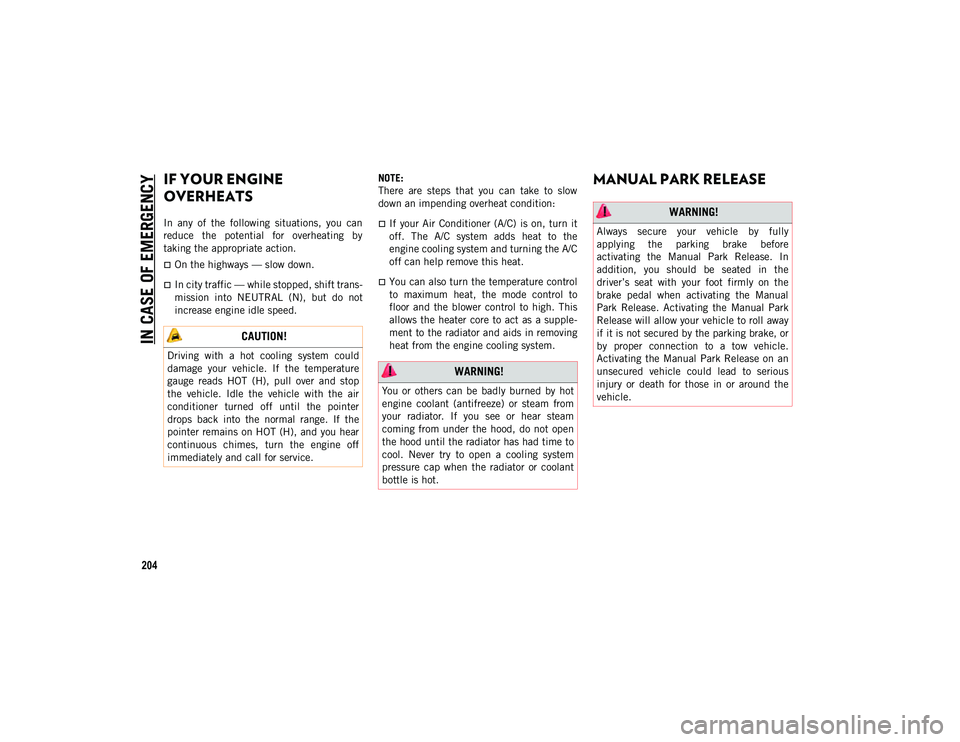
IN CASE OF EMERGENCY
204
IF YOUR ENGINE
OVERHEATS
In any of the following situations, you can
reduce the potential for overheating by
taking the appropriate action.
On the highways — slow down.
In city traffic — while stopped, shift trans-
mission into NEUTRAL (N), but do not
increase engine idle speed.NOTE:
There are steps that you can take to slow
down an impending overheat condition:
If your Air Conditioner (A/C) is on, turn it
off. The A/C system adds heat to the
engine cooling system and turning the A/C
off can help remove this heat.
You can also turn the temperature control
to maximum heat, the mode control to
floor and the blower control to high. This
allows the heater core to act as a supple-
ment to the radiator and aids in removing
heat from the engine cooling system.
MANUAL PARK RELEASE
CAUTION!
Driving with a hot cooling system could
damage your vehicle. If the temperature
gauge reads HOT (H), pull over and stop
the vehicle. Idle the vehicle with the air
conditioner turned off until the pointer
drops back into the normal range. If the
pointer remains on HOT (H), and you hear
continuous chimes, turn the engine off
immediately and call for service.
WARNING!
You or others can be badly burned by hot
engine coolant (antifreeze) or steam from
your radiator. If you see or hear steam
coming from under the hood, do not open
the hood until the radiator has had time to
cool. Never try to open a cooling system
pressure cap when the radiator or coolant
bottle is hot.
WARNING!
Always secure your vehicle by fully
applying the parking brake before
activating the Manual Park Release. In
addition, you should be seated in the
driver’s seat with your foot firmly on the
brake pedal when activating the Manual
Park Release. Activating the Manual Park
Release will allow your vehicle to roll away
if it is not secured by the parking brake, or
by proper connection to a tow vehicle.
Activating the Manual Park Release on an
unsecured vehicle could lead to serious
injury or death for those in or around the
vehicle.
2020_JEEP_JL_WRANGLER_UG_RHD_UK.book Page 204
Page 207 of 330
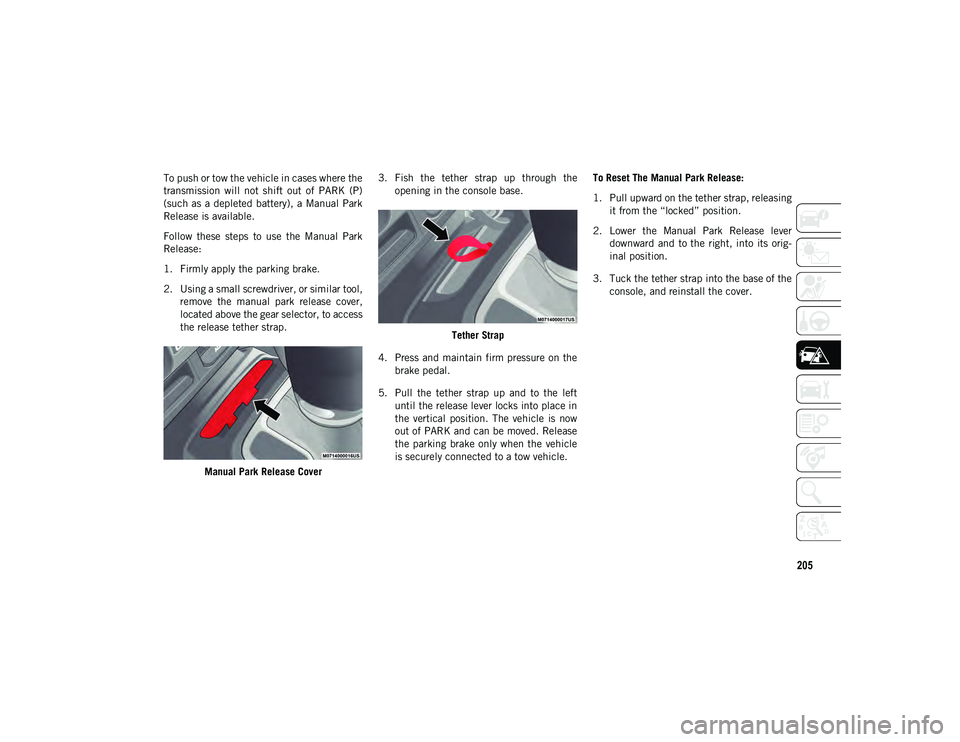
205
To push or tow the vehicle in cases where the
transmission will not shift out of PARK (P)
(such as a depleted battery), a Manual Park
Release is available.
Follow these steps to use the Manual Park
Release:
1. Firmly apply the parking brake.
2. Using a small screwdriver, or similar tool,remove the manual park release cover,
located above the gear selector, to access
the release tether strap.
Manual Park Release Cover 3. Fish the tether strap up through the
opening in the console base.
Tether Strap
4. Press and maintain firm pressure on the brake pedal.
5. Pull the tether strap up and to the left until the release lever locks into place in
the vertical position. The vehicle is now
out of PARK and can be moved. Release
the parking brake only when the vehicle
is securely connected to a tow vehicle. To Reset The Manual Park Release:
1. Pull upward on the tether strap, releasing
it from the “locked” position.
2. Lower the Manual Park Release lever downward and to the right, into its orig -
inal position.
3. Tuck the tether strap into the base of the console, and reinstall the cover.
2020_JEEP_JL_WRANGLER_UG_RHD_UK.book Page 205
Page 208 of 330
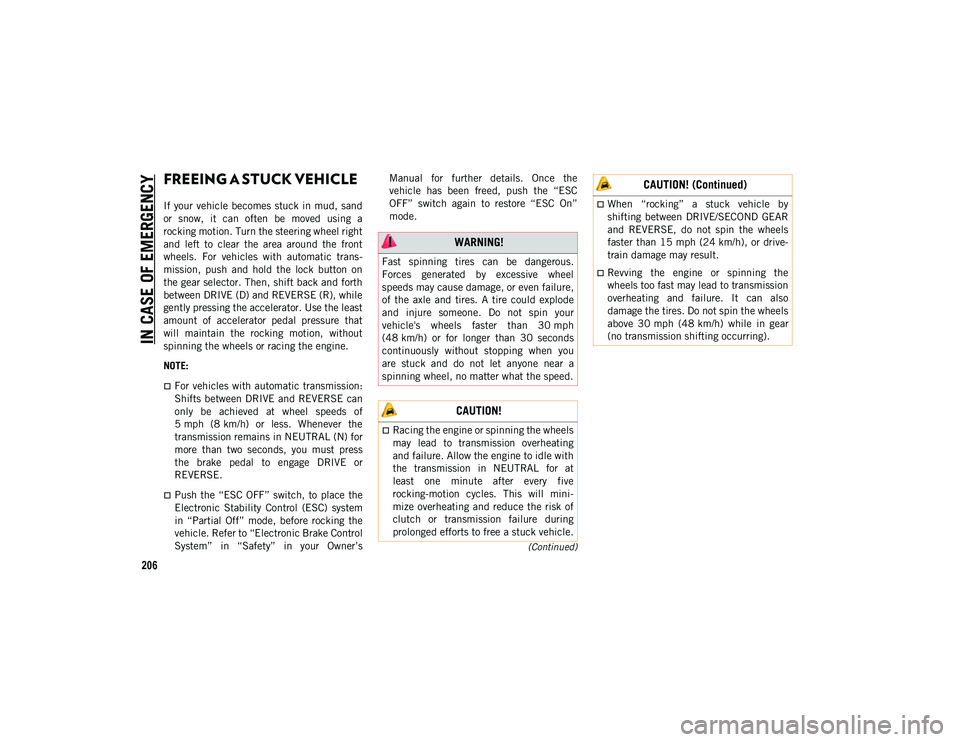
IN CASE OF EMERGENCY
206
(Continued)
FREEING A STUCK VEHICLE
If your vehicle becomes stuck in mud, sand
or snow, it can often be moved using a
rocking motion. Turn the steering wheel right
and left to clear the area around the front
wheels. For vehicles with automatic trans-
mission, push and hold the lock button on
the gear selector. Then, shift back and forth
between DRIVE (D) and REVERSE (R), while
gently pressing the accelerator. Use the least
amount of accelerator pedal pressure that
will maintain the rocking motion, without
spinning the wheels or racing the engine.
NOTE:
For vehicles with automatic transmission:
Shifts between DRIVE and REVERSE can
only be achieved at wheel speeds of
5 mph (8 km/h) or less. Whenever the
transmission remains in NEUTRAL (N) for
more than two seconds, you must press
the brake pedal to engage DRIVE or
REVERSE.
Push the “ESC OFF” switch, to place the
Electronic Stability Control (ESC) system
in “Partial Off” mode, before rocking the
vehicle. Refer to “Electronic Brake Control
System” in “Safety” in your Owner’s Manual for further details. Once the
vehicle has been freed, push the “ESC
OFF” switch again to restore “ESC On”
mode.
WARNING!
Fast spinning tires can be dangerous.
Forces generated by excessive wheel
speeds may cause damage, or even failure,
of the axle and tires. A tire could explode
and injure someone. Do not spin your
vehicle's wheels faster than 30 mph
(48 km/h) or for longer than 30 seconds
continuously without stopping when you
are stuck and do not let anyone near a
spinning wheel, no matter what the speed.
CAUTION!
Racing the engine or spinning the wheels
may lead to transmission overheating
and failure. Allow the engine to idle with
the transmission in NEUTRAL for at
least one minute after every five
rocking-motion cycles. This will mini
-
mize overheating and reduce the risk of
clutch or transmission failure during
prolonged efforts to free a stuck vehicle.
When “rocking” a stuck vehicle by
shifting between DRIVE/SECOND GEAR
and REVERSE, do not spin the wheels
faster than 15 mph (24 km/h), or drive -
train damage may result.
Revving the engine or spinning the
wheels too fast may lead to transmission
overheating and failure. It can also
damage the tires. Do not spin the wheels
above 30 mph (48 km/h) while in gear
(no transmission shifting occurring).
CAUTION! (Continued)
2020_JEEP_JL_WRANGLER_UG_RHD_UK.book Page 206
Page 209 of 330
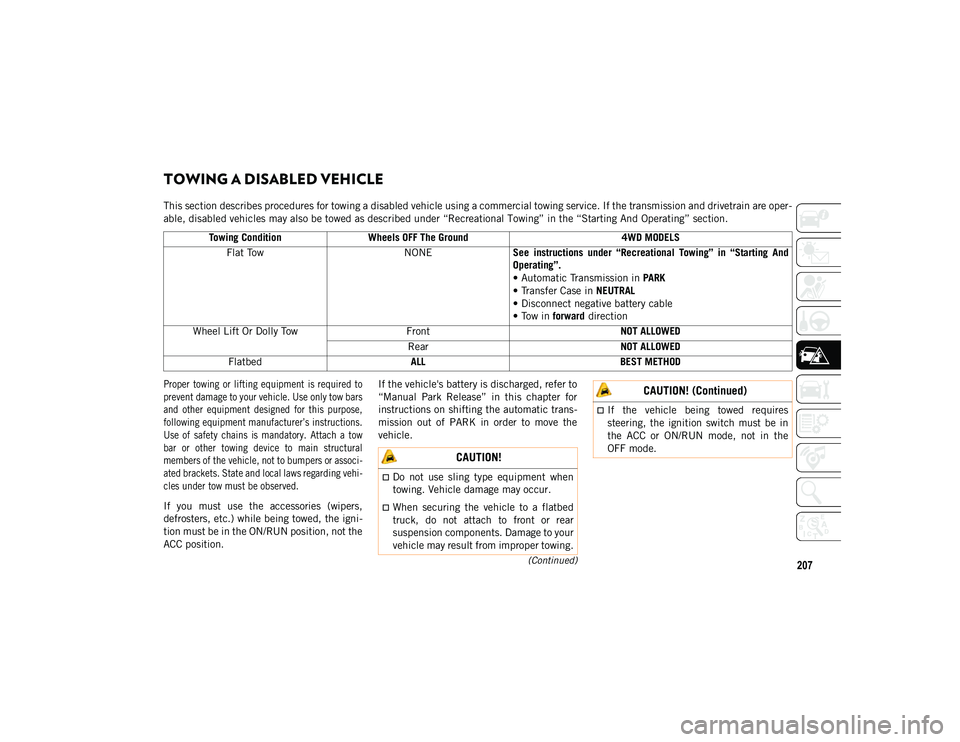
207(Continued)
TOWING A DISABLED VEHICLE
This section describes procedures for towing a disabled vehicle using a commercial towing service. If the transmission and drivetrain are oper-
able, disabled vehicles may also be towed as described under “Recreational Towing” in the “Starting And Operating” section.
Proper towing or lifting equipment is required to
prevent damage to your vehicle. Use only tow bars
and other equipment designed for this purpose,
following equipment manufacturer’s instructions.
Use of safety chains is mandatory. Attach a tow
bar or other towing device to main structural
members of the vehicle, not to bumpers or associ -
ated brackets. State and local laws regarding vehi -
cles under tow must be observed.
If you must use the accessories (wipers,
defrosters, etc.) while being towed, the igni -
tion must be in the ON/RUN position, not the
ACC position. If the vehicle's battery is discharged, refer to
“Manual Park Release” in this chapter for
instructions on shifting the automatic trans
-
mission out of PARK in order to move the
vehicle.
Towing Condition
Wheels OFF The Ground 4WD MODELS
Flat Tow NONESee instructions under “Recreational Towing” in “Starting And
Operating”.
• Automatic Transmission in PARK
• Transfer Case in NEUTRAL
• Disconnect negative battery cable
• Tow in forward direction
Wheel Lift Or Dolly Tow Front NOT ALLOWED
Rear NOT ALLOWED
Flatbed ALL BEST METHOD
CAUTION!
Do not use sling type equipment when
towing. Vehicle damage may occur.
When securing the vehicle to a flatbed
truck, do not attach to front or rear
suspension components. Damage to your
vehicle may result from improper towing.
If the vehicle being towed requires
steering, the ignition switch must be in
the ACC or ON/RUN mode, not in the
OFF mode.
CAUTION! (Continued)
2020_JEEP_JL_WRANGLER_UG_RHD_UK.book Page 207
Page 210 of 330
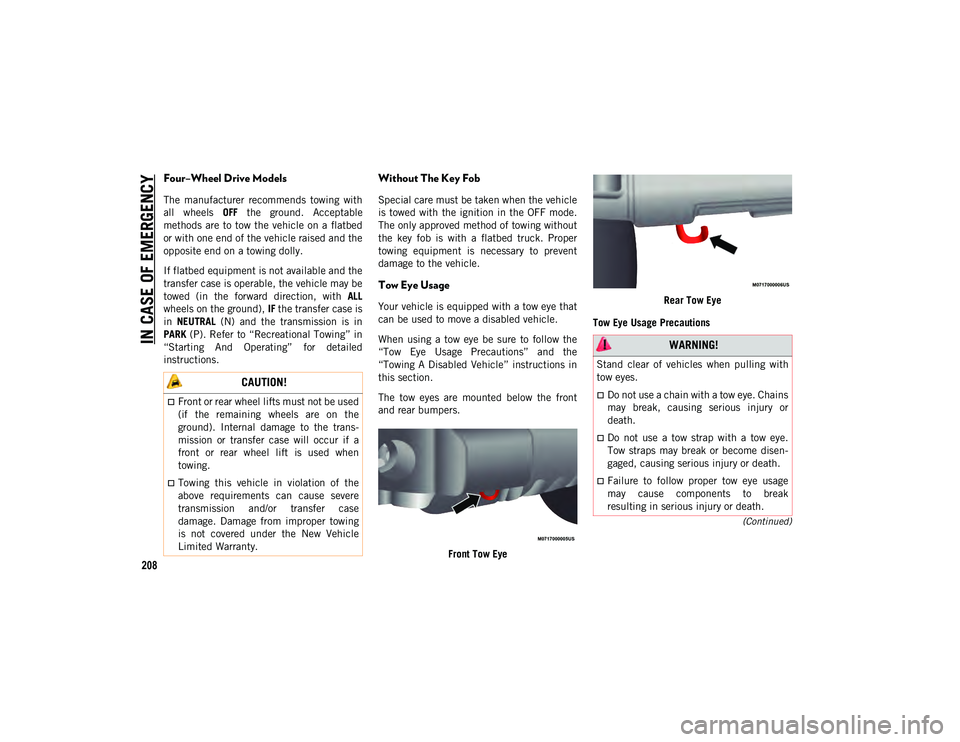
IN CASE OF EMERGENCY
208
(Continued)
Four–Wheel Drive Models
The manufacturer recommends towing with
all wheels OFF the ground. Acceptable
methods are to tow the vehicle on a flatbed
or with one end of the vehicle raised and the
opposite end on a towing dolly.
If flatbed equipment is not available and the
transfer case is operable, the vehicle may be
towed (in the forward direction, with ALL
wheels on the ground), IF the transfer case is
in NEUTRAL (N) and the transmission is in
PARK (P). Refer to “Recreational Towing” in
“Starting And Operating” for detailed
instructions.
Without The Key Fob
Special care must be taken when the vehicle
is towed with the ignition in the OFF mode.
The only approved method of towing without
the key fob is with a flatbed truck. Proper
towing equipment is necessary to prevent
damage to the vehicle.
Tow Eye Usage
Your vehicle is equipped with a tow eye that
can be used to move a disabled vehicle.
When using a tow eye be sure to follow the
“Tow Eye Usage Precautions” and the
“Towing A Disabled Vehicle” instructions in
this section.
The tow eyes are mounted below the front
and rear bumpers.
Front Tow Eye Rear Tow Eye
Tow Eye Usage Precautions
CAUTION!
Front or rear wheel lifts must not be used
(if the remaining wheels are on the
ground). Internal damage to the trans-
mission or transfer case will occur if a
front or rear wheel lift is used when
towing.
Towing this vehicle in violation of the
above requirements can cause severe
transmission and/or transfer case
damage. Damage from improper towing
is not covered under the New Vehicle
Limited Warranty.
WARNING!
Stand clear of vehicles when pulling with
tow eyes.
Do not use a chain with a tow eye. Chains
may break, causing serious injury or
death.
Do not use a tow strap with a tow eye.
Tow straps may break or become disen -
gaged, causing serious injury or death.
Failure to follow proper tow eye usage
may cause components to break
resulting in serious injury or death.
2020_JEEP_JL_WRANGLER_UG_RHD_UK.book Page 208